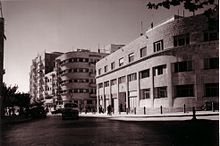General election in Israel, 1949
- Maki : 4
- Mapam : 19
- Nazareth : 2
- Mapai : 46
- WIZO : 1
- MP : 5
- Yemeni Association : 1
- General Zionists : 7
- Sephardi and communities of the Orient : 4
- VRF : 16
- Cherut : 14
- Reshimat HaLohmim : 1
The first election in Israel after the proclamation of independence took place on January 25, 1949 as the constituent assembly election. The meeting first met on February 14, 1949. On February 16, 1949, it was converted into the Israeli parliament, the Knesset , by law.
Election result
| Eligible voters | 506,567 |
| Votes cast | 434,684 |
| voter turnout | 85.8% |
| Threshold clause (1.0%) | 4346 votes |
| Votes per seat | 3592 |
| Political party | be right | percent |
|---|---|---|
| Mapai | 155.274 | 35.7 |
| Mapam | 64.018 | 14.7 |
| HaChasit haDatit haMe'uchedet (United Religious Front) | 52,982 | 12.2 |
| Cherut | 49,782 | 11.5 |
| Tzionim Klaliym (General Zionists) | 22,661 | 5.2 |
| Miflaga Progresivit (Progressive Party) | 17,786 | 4.1 |
| Sfaradim VeEdot Misrach (Sephardic and Oriental Communities) | 15,287 | 3.5 |
| Maki | 15,148 | 3.5 |
| Reschima Demokratit schel Natzrat (Democratic List of Nazareth) | 7,387 | 1.7 |
| Reshimat HaLohmim (List of Fighters) | 5,363 | 1.2 |
| Women's International Zionist Organization | 5,173 | 1.2 |
| Hitachdut HaTeimanim beJisra'el (Yemeni Association) | 4,399 | 1.0 |
| nine more groups and lists | 19,424 | 4.5 |
Session
The first meeting took place on February 14, 1949. The first Knesset was in office for 2 years and 6 months.
| Political party | percent | Seats | Seats 1 |
|---|---|---|---|
| Mapai | 35.7% | 46 | 46 |
| Mapam | 14.7% | 19th | 20th |
| HaChasit haDatit haMe'uchedet | 12.2% | 16 | 16 |
| Cherut | 11.5% | 14th | 12 |
| General Zionists | 5.2 | 7th | 7th |
| Miflaga Progresivit | 4.1% | 5 | 5 |
| Sfaradim VeEdot Misrach | 3.5% | 4th | 4th |
| Maki | 3.5% | 4th | 3 |
| Reschima Demokratit schel Natzrat | 1.7% | 2 | 2 |
| Reshimat HaLohmim | 1.2% | 1 | 1 |
| Women's International Zionist Organization | 1.2 | 1 | 1 |
| Hitachdut HaTeimanim beJisra'el | 1.0 | 1 | 1 |
| Individual MPs | - | - | 2 |
| total | 95.5% | 120 | 120 |
Seat 1 : Seats at the end of the legislative period
- Eliezer Preminger left Maki, briefly founded the Hebrew Communist Party before joining the Mapam.
- Ari Jabotinsky and Hillel Kook left the Cherut and were Independent Members of the Knesset.
Governments
- March 8, 1949 to October 15, 1950: Cabinet David Ben-Gurion I
- October 30, 1950 to February 14, 1951: Cabinet David Ben-Gurion II
history
The constituent meeting took place on February 14, 1949. Yosef Sprinzak was elected President of Parliament. On February 16, the Constituent Assembly was transformed into a parliament called the Knesset. Among other things, the Knesset was given the task of drafting and adopting a constitution. On the same day Chaim Weizmann was elected President . The first government , led by Mapai chairman David Ben-Gurion , was formed on March 8, 1949. The main opposition party was the Cherut , led by Menachem Begin .
When the legal system was created, the existing order of the British mandate was largely adopted . Nevertheless, around 7.5 laws a month were passed in the first Knesset. Due to differences between the various parties and groups, however, it was not possible to work out a quorum. Important points in the debates were the negotiations on peace treaties after the armistice after the war of independence and the positioning in international politics. Further topics were the orientation of the economic policy of the state, the form of citizenship and the handling of the former armed groups of the various political organizations.
The law on the ombudsman , flag and coat of arms was passed on May 18, 1949. After a debate on the seat of parliament in mid-December, the Knesset met for the first time on December 26, 1949 in the Jewish Agency building in Jerusalem . On March 13, 1950, the first session took place in the Froumine House on King Georg Street in the center of Jerusalem. On January 23, 1950 the construction of a separate building for the government and for the Knesset was decided; on June 13, 1950, the Hariri Resolution was passed, stating that a constitution should be established in the form of individual basic laws, and on July 5, 1950, the Law of Return was passed.
On October 16, 1950, Ben-Gurion announced the end of his government. The reasons were differences within the government regarding the occupation of the Ministry of Trade and Industry , the abolition of the Ministry of rationing and stockpiling and, above all, regulations for the form of school education in the immigration camps.
On November 1, 1950, after several negotiations, the second cabinet under Ben-Gurion was formed. This government, too, resigned on February 14, 1951 because of unresolved questions about the school system in the immigration camps. Business was provisionally continued until the next Knesset election on July 30, 1951 . In 1950 laws were passed on working hours, rest hours, the rights and duties of Knesset members, and equal rights for women.
The first parliamentary inquiry committee dealt with a police operation in the Jalami camp.
See also
Web links
- History of the first Knesset (Engl.)
Footnotes


